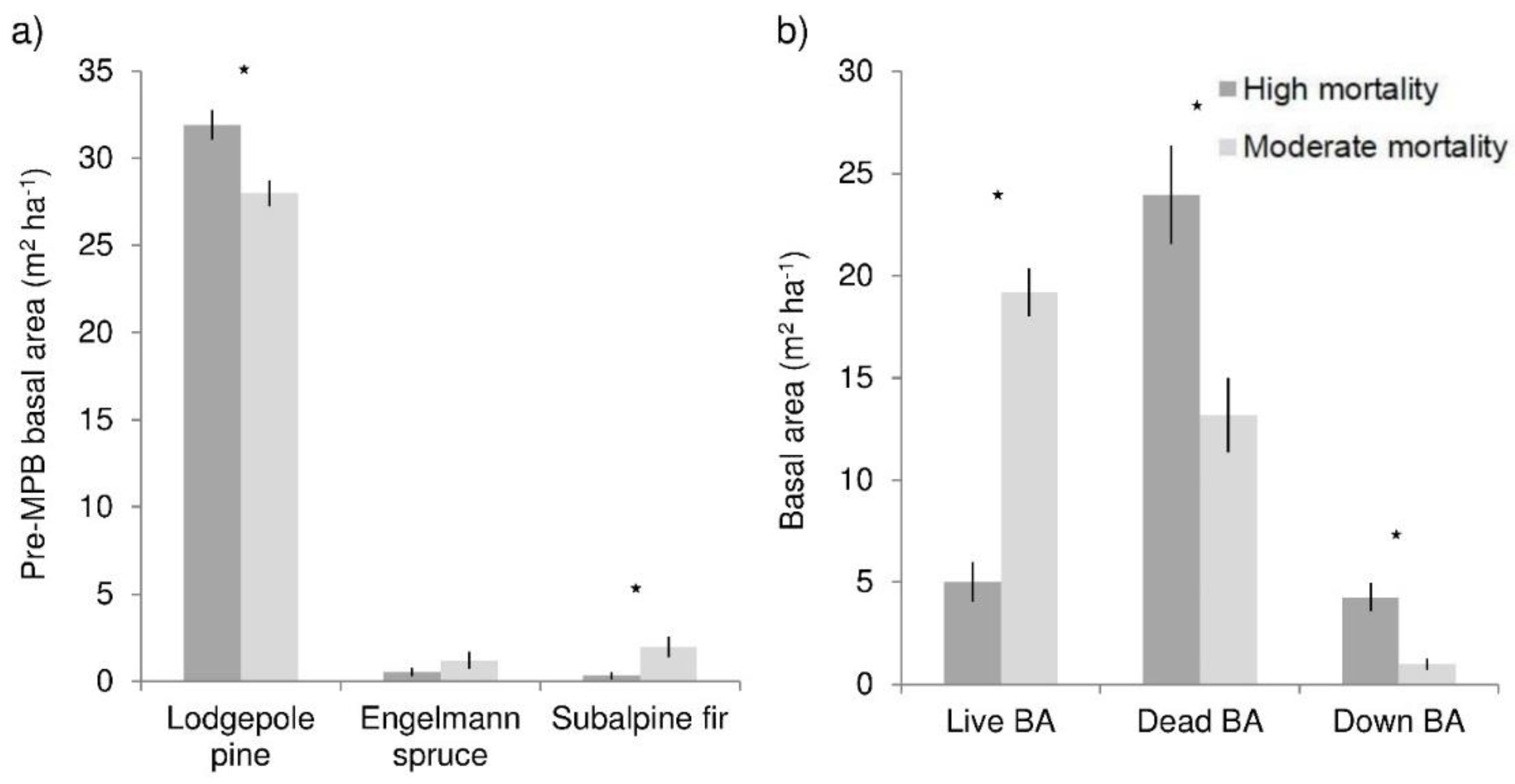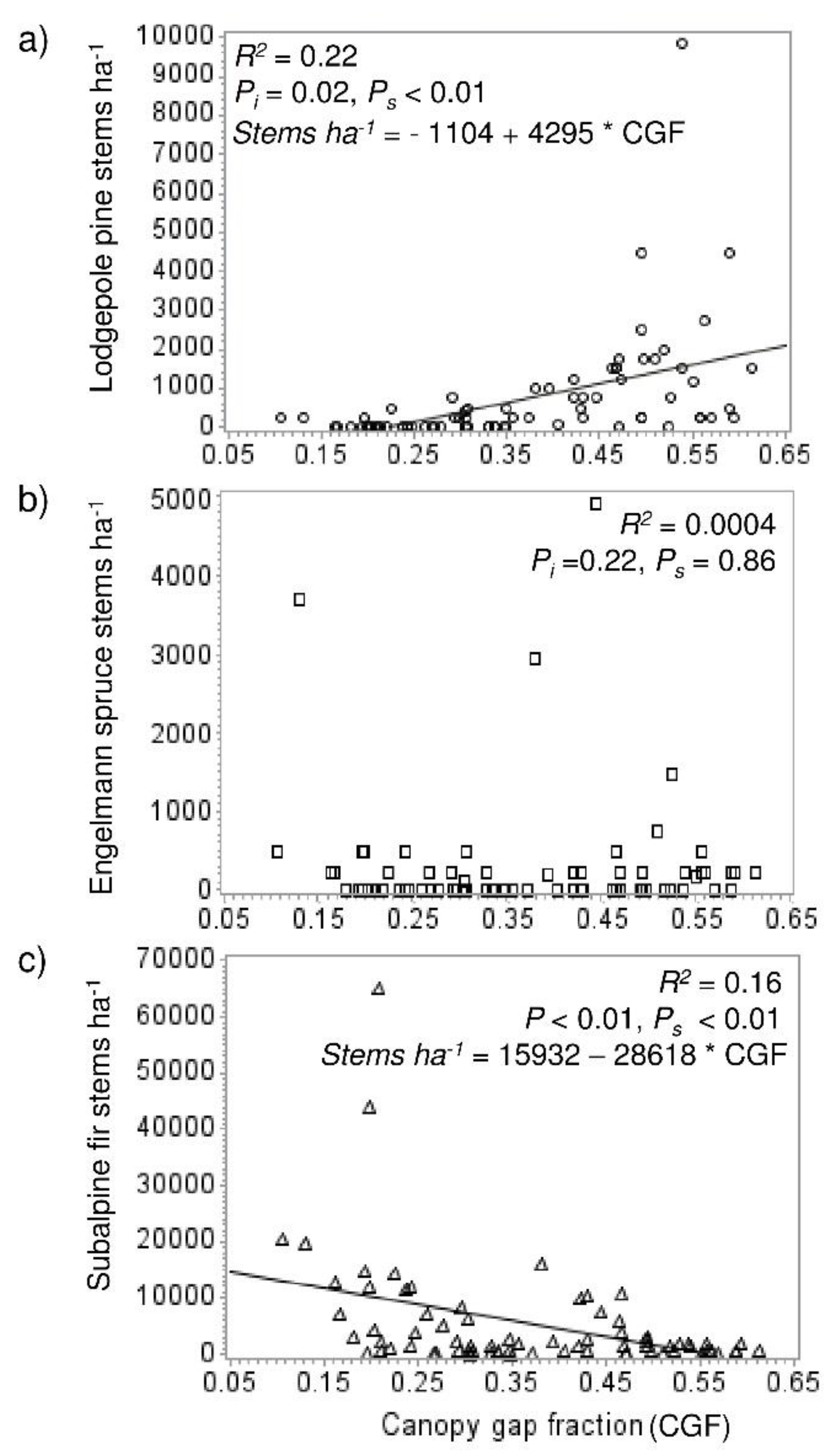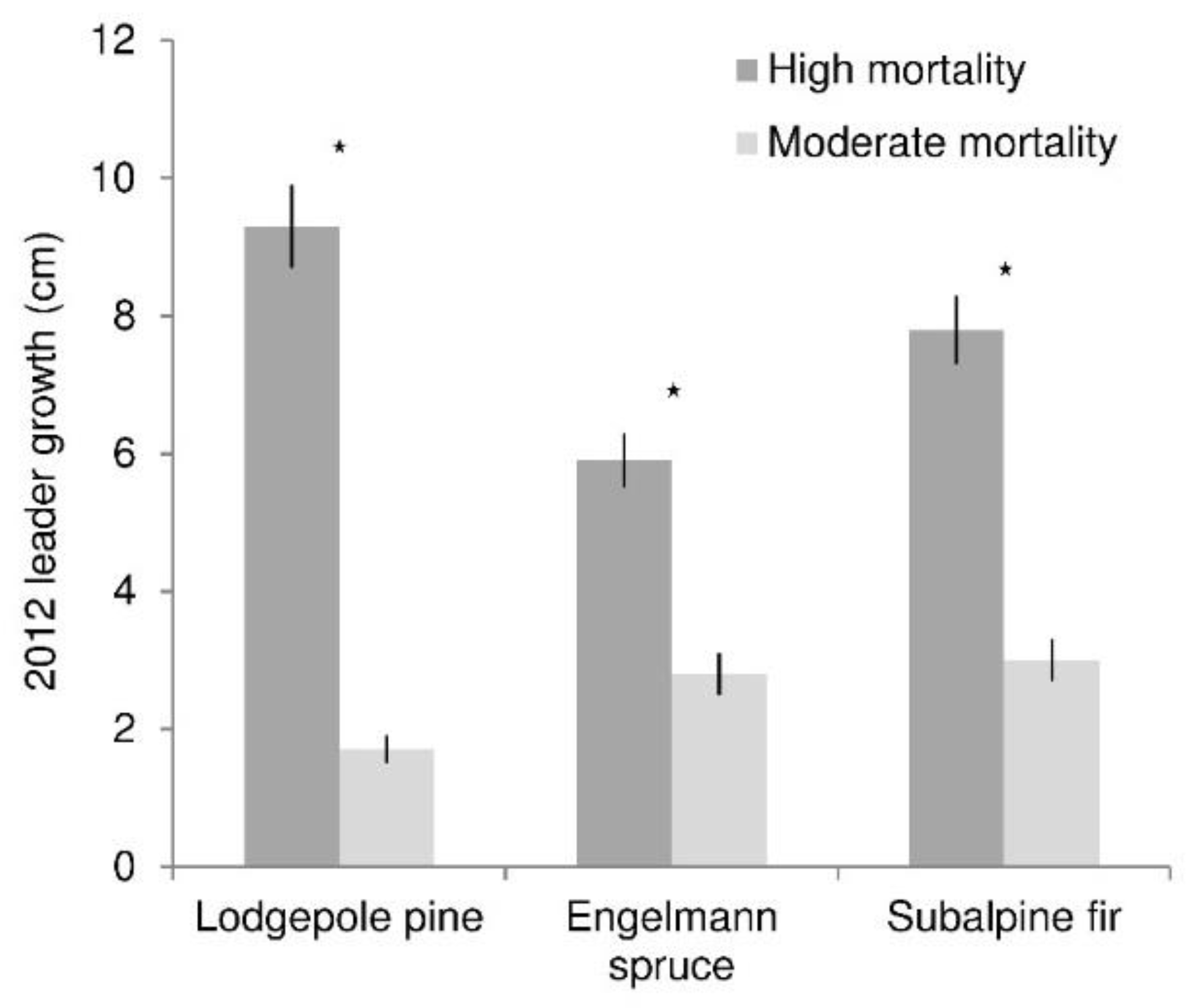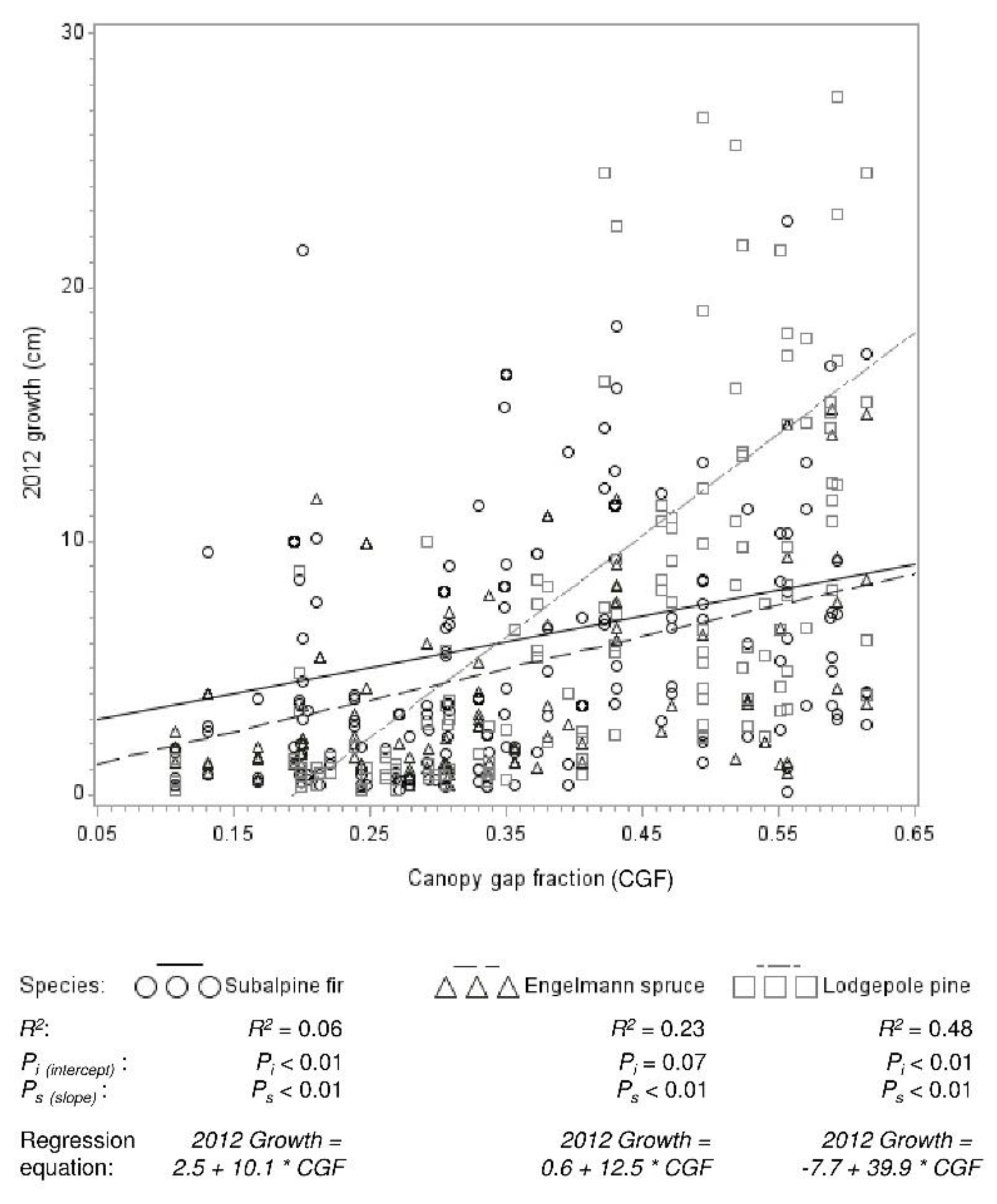Severity of Overstory Mortality Influences Conifer Recruitment and Growth in Mountain Pine Beetle-Affected Forests
Abstract
:1. Introduction
2. Materials and Methods
2.1. Study Area
2.2. Study Design
2.3. Tree Data Collection
2.4. Canopy Density Data Collection and Processing
2.5. Soil Temperature and Moisture
2.6. Statistical Analysis
3. Results
3.1. Forest Overstory and Understory
3.2. Regeneration Density and Growth
3.3. Soil Moisture and Temperature
3.4. Forest Floor and Recruitment Distribution
4. Discussion
5. Conclusions
Author Contributions
Funding
Acknowledgments
Conflicts of Interest
References
- Meddens, A.J.H.; Hicke, J.A. Spatiotemporal patterns of observed bark beetle-caused tree mortality in British Columbia and the western United States. Ecol. Appl. 2012, 22, 1876–1891. [Google Scholar] [CrossRef] [PubMed]
- Meddens, A.J.H.; Hicke, J.A. Spatial and temporal patterns of Landsat-based detection of tree mortality caused by a mountain pine beetle outbreak in Colorado, USA. For. Ecol. Manag. 2014, 322, 78–88. [Google Scholar] [CrossRef]
- USDA Forest Service. Forest Insect and Disease Aerial Survey Data, Rocky Mountain Region; USDA Forest Service State and Private Forestry, Forest Health Protection: Lakewood, CO, USA, 2013.
- Miles, P.D. Forest Inventory EVALIDator Web-Application Version 1.6.0.03. Available online: http://apps.fs.fed.us/Evalidator/evalidator.jsp (accessed on 17 October 2013).
- Chen, J.Q.; Franklin, J.F.; Spies, T.A. Contrasting microclimates among clear-cut, edge, and interior of old-growth Douglas-fir forest. Agric. For. Meteorol. 1993, 63, 219–237. [Google Scholar] [CrossRef]
- Knapp, A.K.; Smith, W.K. Factors influencing understory seedling establishment of Engelmann spruce (Picea engelmannii) and subalpine fir (Abies lasiocarpa) in southeast Wyoming. Can. J. Bot. 1982, 60, 2753–2761. [Google Scholar] [CrossRef]
- Dai, X.B. Influence of light conditions in canopy gaps on forest regeneration: A new gap light index and its application in a boreal forest in east-central Sweden. For. Ecol. Manag. 1996, 84, 187–197. [Google Scholar] [CrossRef]
- Feller, M.C. Influence of ecological conditions on Engelmann spruce (Picea engelmannii) and subalpine fir (Abies lasiocarpa) germinant survival and initial seedling growth in south-central British Columbia. For. Ecol. Manag. 1998, 107, 55–69. [Google Scholar] [CrossRef]
- Winkler, R.; Boon, S.; Zimonick, B.; Spittlehouse, D. Snow accumulation and ablation response to changes in forest structure and snow surface albedo after attack by mountain pine beetle. Hydrol. Process. 2014, 28, 197–209. [Google Scholar] [CrossRef]
- Adams, R.S.; Black, T.A.; Fleming, R.L. Evapotranspiration and surface conductance in a high elevation, grass-covered forest clear-cut. Agric. For. Meteorol. 1991, 56, 173–193. [Google Scholar] [CrossRef]
- Hubbard, R.M.; Rhoades, C.C.; Elder, K.; Negron, J. Changes in transpiration and foliage growth in lodgepole pine trees following mountain pine beetle attack and mechanical girdling. For. Ecol. Manag. 2013, 289, 312–317. [Google Scholar] [CrossRef]
- George, L.O.; Bazzaz, F.A. The fern understory as an ecological filter: Emergence and establishment of canopy-tree seedlings. Ecology 1999, 80, 833–845. [Google Scholar] [CrossRef]
- Oliver, C.D.; Larson, B.C. Forest Stand Dynamics; John Wiley and Sons: Hoboken, NJ, USA, 1996. [Google Scholar]
- Chan-McLeod, A.C. A review and synthesis of the effects of unsalvaged mountain-pine-beetle-attacked stands on wildlife and implications for forest management. BC J. Ecosyst. Manag. 2006, 7, 119–132. [Google Scholar]
- Page, W.G.; Jenkins, M.J. Mountain pine beetle-induced changes to selected lodgepole pine fuel complexes within the Intermountain region. For. Sci. 2007, 53, 507–518. [Google Scholar]
- Pelz, K.A.; Rhoades, C.C.; Hubbard, R.M.; Battaglia, M.A.; Smith, F.W. Species composition influences management outcomes following mountain pine beetle in lodgepole pine-dominated forests. For. Ecol. Manag. 2015, 336, 11–20. [Google Scholar] [CrossRef]
- Pugh, E.; Gordon, E. A conceptual model of water yield effects from beetle-induced tree death in snow-dominated lodgepole pine forests. Hydrol. Process. 2013, 27, 2048–2060. [Google Scholar] [CrossRef]
- Astrup, R.; Coates, K.D.; Hall, E. Recruitment limitation in forests: Lessons from an unprecedented mountain pine beetle epidemic. For. Ecol. Manag. 2008, 256, 1743–1750. [Google Scholar] [CrossRef]
- Klutsch, J.G.; Negrón, J.F.; Costello, S.L.; Rhoades, C.C.; West, D.R.; Popp, J.; Caissie, R. Stand characteristics and downed woody debris accumulations associated with a mountain pine beetle outbreak in Colorado. For. Ecol. Manag. 2009, 258, 641–649. [Google Scholar] [CrossRef]
- Vyse, A.; Ferguson, C.; Huggard, D.J.; Roach, J.; Zimonick, B. Regeneration beneath lodgepole pine dominated stands attacked or threatened by the mountain pine beetle in the south central Interior, British Columbia. For. Ecol. Manag. 2009, 258, S36–S43. [Google Scholar] [CrossRef]
- Collins, B.J.; Rhoades, C.C.; Hubbard, R.M.; Battaglia, M.A. Tree regeneration and future stand development after bark beetle infestation and harvesting in Colorado lodgepole pine forests. For. Ecol. Manag. 2011, 261, 2168–2745. [Google Scholar] [CrossRef]
- Diskin, M.; Rocca, M.E.; Nelson, K.N.; Aoki, C.F.; Romme, W.H. Forest developmental trajectories in mountain pine beetle disturbed forests of Rocky Mountain National Park, Colorado. Can. J. For. Res. 2011, 41, 782–792. [Google Scholar] [CrossRef]
- Kayes, L.J.; Tinker, D.B. Forest structure and regeneration following a mountain pine beetle epidemic in southeastern Wyoming. For. Ecol. Manag. 2012, 263, 57–66. [Google Scholar] [CrossRef]
- Pelz, K.A.; Smith, F.W. Thirty year change in lodgepole and lodgepole/mixed conifer forest structure following 1980s mountain pine beetle outbreak in western Colorado, USA. For. Ecol. Manag. 2012, 280, 93–102. [Google Scholar] [CrossRef]
- Rhoades, C.C.; Pelz, K.A.; Fornwalt, P.J.; Wolk, B.H.; Cheng, A.S. Overlapping bark beetle outbreaks, salvage logging and wildfire restructure a lodgepole pine ecosystem. Forests 2018, 9, 101. [Google Scholar] [CrossRef]
- Tishmack, J.; Mata, S.A.; Schmid, J.M.; Porth, L. Mountain Pine Beetle Emergence from Lodgepole Pine at Different Elevations Near Fraser, CO; Unpublished Draft; USDA Forest Service, Rocky Mountain Research Station: Fort Collins, CO, USA, 2004.
- Rhoades, C.C.; Hubbard, R.M.; Elder, K. A decade of streamwater nitrogen and forest dynamics after a mountain pine beetle outbreak at the Fraser Experimental Forest, Colorado. Ecosystems 2017, 20, 380–392. [Google Scholar] [CrossRef]
- Alstatt, D.; Miles, R.L. Soil Survey of Grand County Area, Colorado; USDA Soil Conservation Service and Forest Service: Fort Collins, CO, USA, 1983.
- Brown, P.M.; Shepperd, W.D.; Mata, S.A.; McClain, D.L. Longevity of windthrow logs in a subalpine forest of central Colorado. Can. J. For. Res. 1998, 28, 932–936. [Google Scholar] [CrossRef]
- Wilm, H.G.; Dunford, E.G. Effect of Timber Cutting on Water Available for Stream Flow from A Lodgepole Pine Forest; US Department of Agriculture: Washington, DC, USA, 1948; p. 43.
- Alexander, R.R.; Watkins, R.K. The Fraser Experimental Forest, Colorado; GTR-RM-40; USDA Forest Service: Fort Collins, CO, USA, 1977; p. 32.
- Chianucci, F.; Cutini, A. Digital hemispherical photography for estimating forest canopy properties: Current controversies and opportunities. iForest 2012, 5, 290–295. [Google Scholar] [CrossRef]
- Schleppi, P.; Conedera, M.; Sedivy, I.; Thimonier, A. Correcting non-linearity and slope effects in the estimation of the leaf area index of forests from hemispherical photographs. Agric. For. Meteorol. 2007, 144, 236–242. [Google Scholar] [CrossRef]
- Sibold, J.S.; Veblen, T.T.; Chipko, K.; Lawson, L.; Mathis, E.; Scott, J. Influences of secondary disturbances on lodgepole pine stand development in Rocky Mountain National Park. Ecol. Appl. 2007, 17, 1638–1655. [Google Scholar] [CrossRef] [PubMed]
- Lotan, J.E. Initial Germination and Survival of Lodgepole Pine on Prepared Seedbeds; INT-RN-29; USDA Forest Service Intermountain Research Station: Ogden, UT, USA, 1964; p. 7.
- Lotan, J.E.; Critchfield, W.B. Pinus contorta Doug. ex. Loud.—Lodgepole Pine. In Silvics of North America: Conifers; Burns, R.M., Honkala, B.H., Eds.; USDA Forest Service: Washington, DC, USA, 1990; Volume 1. [Google Scholar]
- Alexander, R.R.; Shearer, R.C.; Shepperd, W.D. Abies lasiocarpa (Hook.) Nutt.—Subalpine Fir. In Silvics of North America: Conifers; Burns, R.M., Honkala, B.H., Eds.; USDA Forest Service: Washington, DC, USA, 1990; Volume 1. [Google Scholar]
- Cui, M.; Smith, W.K. Photosynthesis, water relations and mortality in Abies lasiocarpa seedlings during natural establishment. Tree Phys. 1991, 8, 37–46. [Google Scholar] [CrossRef]
- Noble, D.L.; Alexander, R.R. Environmental factors affecting natural regeneration of Engelmann spruce in the central Rocky Mountains. For. Sci. 1977, 23, 420–429. [Google Scholar]
- Alexander, R.R.; Shepperd, W.D. Picea engelmannii Parry ex Engelm.—Engelmann Spruce. In Silvics of North America: Conifers; Burns, R.M., Honkala, B.H., Eds.; USDA Forest Service: Washington, DC, USA, 1990; Volume 1. [Google Scholar]
- Aplet, G.H.; Laven, R.D.; Smith, F.W. Patterns of community dynamics in Colorado Engelmann spruce-subalpine fir forests. Ecology 1988, 69, 312–319. [Google Scholar] [CrossRef]
- Veblen, T.T. The response of subalpine forest to spruce beetle outbreak in Colorado. Ecology 1991, 72, 213–231. [Google Scholar] [CrossRef]
- Stone, W.E.; Wolfe, M.L. Response of understory vegetation to variable tree mortality following a mountain pine beetle epidemic in lodgepole pine stands in northern Utah. Vegetatio 1996, 122, 1–12. [Google Scholar] [CrossRef] [Green Version]





| Substrate | Observed Substrate Cover (%) | |
|---|---|---|
| Mortality Level | ||
| High | Moderate | |
| Duff/litter * | 44 | 57 |
| Vaccinium spp. | 25 | 23 |
| Wood debris * | 16 | 9 |
| Shrubs/conifer branches | 9 | 6 |
| Lichen/moss | 3 | 3 |
| Rock | 1 | 1 |
| Forbs/gramminoids | 1 | <1 |
| Mineral soil | <1 | <1 |
© 2018 by the authors. Licensee MDPI, Basel, Switzerland. This article is an open access article distributed under the terms and conditions of the Creative Commons Attribution (CC BY) license (http://creativecommons.org/licenses/by/4.0/).
Share and Cite
Pelz, K.A.; Rhoades, C.C.; Hubbard, R.M.; Smith, F.W. Severity of Overstory Mortality Influences Conifer Recruitment and Growth in Mountain Pine Beetle-Affected Forests. Forests 2018, 9, 536. https://doi.org/10.3390/f9090536
Pelz KA, Rhoades CC, Hubbard RM, Smith FW. Severity of Overstory Mortality Influences Conifer Recruitment and Growth in Mountain Pine Beetle-Affected Forests. Forests. 2018; 9(9):536. https://doi.org/10.3390/f9090536
Chicago/Turabian StylePelz, Kristen A., Charles C. Rhoades, Robert M. Hubbard, and Frederick W. Smith. 2018. "Severity of Overstory Mortality Influences Conifer Recruitment and Growth in Mountain Pine Beetle-Affected Forests" Forests 9, no. 9: 536. https://doi.org/10.3390/f9090536






